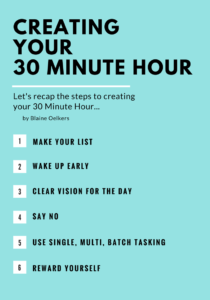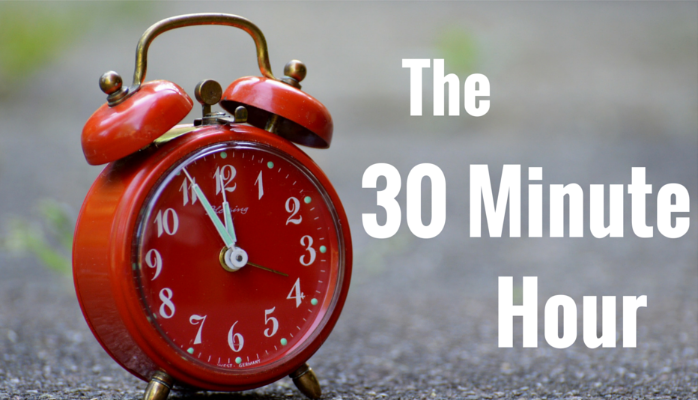Do you need more time? Do you get everything done that you want? What if there was a way to get an hour’s worth of stuff done in just 30 minutes? What would that do to your productivity? How could that free up your day? What if you could teach that to others around you and they started getting an hour’s worth of stuff done in just 30 minutes?
It is possible – I call it The 30 Minute Hour.
You can literally cut time in half and you already know how to do it because you have already done it! We are going to hone the skill you already have. Think back to your most productive day of the year. This is the day you got three to ten times more work done. Now, remember, we are just looking for two times the productivity not three to ten – so this should be easy! And you are already doing it – typically a few times a year.
What’s your most productive day of the year?
Which day is it? The most productive day of the year is the day before vacation. On the day before vacation, you get three to ten times the amount of work done compared to a normal day. Let’s take a look and unpack this day before vacation. What makes it so successful, from a productivity standpoint? Why are you getting three to ten times the amount of work done? Think about it for a second. Think back. Why do you get so much done on that day? What could you take from that day to create some 30 minute hours?
What makes this day so successful?
The number one thing that creates success on that day is your planning and your list. Because the day before vacation is so packed with so much to do, you plan out the day and make a list. You make a written list because you have so much to do and you don’t want to forget anything. The key is to do it the day before. Either you run the day or the day runs you. If you take nothing else away from this article, if the day before you actually create the list of the things you need to get done, plan it out and prioritize it, you will have some 30 minute hours. Most people have at least two 30 minute hours and earn an extra hour of time just from doing this one thing alone.
Typically, on the day before vacation, people are excited and they’ve got a lot to do. What do they do? The day starts out with them waking up early. They don’t hit the snooze button on that day. They wake up early and get going. I do this every day, I have my list, and I make it the night before. I don’t go to bed without planning the next day. When I wake up, I know what I’m doing and I’m ready to go. You start the day with a clear vision and that brings clear results. That starts every day with a 30 Minute Hour – I’m getting an hour’s worth of a normal morning stuff done in under 30 minutes because I have my plan and my list.
What else happens on this super productive day?
On the day before vacation, you are in the no interruption, no distractions, and “no” mode. There is no chit-chat, you are on a mission. Again, you’ve got limited time and resources, right? You’re focused and you’re saying no. This is a key trait. Probably, you need to say “no” more often. I struggle with not saying “no” enough, but you, on that day before vacation, you say no to new stuff. You say no to the shiny objects, you say no to the rabbit holes, you say no to the worthless meetings that aren’t going to have any result for you.
Another thing you do is to delegate. You can do anything but you can’t do everything – so you have other people help you out. The day before vacation, you’re always asking, “Who can do that?” and “Who can do this?”. I can’t do all these things, so who else can pick up the dry cleaning off, who can call that customer back? Whatever those things are, you’re delegating. You’re delegating much more on those days to other people. It’s easy to delegate your way to a 30 Minute Hour!
How to use the 3 types of tasking.
The next key, to the day before vacation, is your use of tasking. There are three different types of tasking that take place on the day before vacation. One is called single-tasking, the second is called multi-tasking and the third is called batch tasking.
Single-tasking is focusing in on just one single task and shutting everything else out. You are giving it your full attention. My favorite single-tasking is time blocks where I shut out the world to get only the work —the highest priority, profit creating, revenue-generating activities are done.
The second type is multi-tasking. Multi-tasking is when you do two things at the same time. It’s important that you pair two things that can be done together successfully. Trying to talk to someone on the phone and do your email is a poor pairing choice. To do well at those tasks, you should give each your full attention. Successful multi-tasking comes from blending two things together without decreasing your performance on either one. For example, I want to exercise today. I also want to spend time with the kids. I could do an exercise activity with the kids. You’re taking two things and doing them together in a synergistic way. If I was going to spend 30 minutes exercising and 30 minutes with the kids, that would take an hour. If I went for a 30-minute jog with the kids, I just did both of those things and I had a 30 minute hour. I look for multi-tasking opportunities throughout my day. Recently, I wanted to clean my up desk and I had a conference call replay I wanted to listen to. Each of those was 30 minutes long. By doing those together, I just created another 30 Minute Hour. While at Stanford University last year I noticed many people meeting and walking. When I asked about it, it was a great use of multi-tasking. They schedule meetings, not in conference rooms, but rather out on a walk. Getting some exercise, fresh air and getting the work done! Try a walking meeting this week in your business.
Batch tasking, the third one, is grouping similar activities together. For example, the tasks that need to be done on my computer, I can batch together. So when I get to the computer, boom, boom, boom, they can all be done together. Phone calls are better in a batch where you’ve set aside time to do the phone calls one after the other. By batching those together, they take less time. You’ll get a sense of “I’ve got this many calls, in this amount of time” so you’re more diligent about doing those calls and keeping them shorter when you batch them. Running errands is also a good activity to batch together. Things that would take an hour separated can be batched and only take 30 minutes. Tasking is very important in creating 30 Minute Hours.
How that magical day ends…
So then how does it end? The day before vacation ends with you rewarding yourself. You’re going on vacation! It’s a great time to put that back into your day. Have some type of daily reward or at least a weekly reward for yourself. The reward keeps your spirits up and keeps you going.
 Here’s an infographic recap. For a few more ways to create 30 Minute Hours see Part 2 of Module 7 in your Personal Implementation Program inside the Richard James Dashboard.
Here’s an infographic recap. For a few more ways to create 30 Minute Hours see Part 2 of Module 7 in your Personal Implementation Program inside the Richard James Dashboard.
For now, let’s put your day before vacation to work – make your list tonight!
All the best – until next time – take control and make it a great day!
Blaine
Blaine Oelkers is a lifetime entrepreneur, a graduate of Purdue University and Stanford University’s Entrepreneurship program. He’s achieved over 100 Million dollars in sales and coached 1000’s of people. He’s currently the Chief Results Officer for many organizations as well as the President/Founder of a company called Selfluence. He helps business owners and their organizations achieve essentials results using the unique concept of a “Super Results Day”. He can be reached at blaine@selfluence.com.
 Blaine is America’s Chief Results Officer® and the world’s greatest creator of doneness. He knows your results matter and he can help you get better, faster and more long-lasting results. Get started with one simple and elegant results technique that activates your mind with your top goal over 100 times a day. He explains it in a short TEDx talk he did which has been viewed by over 120,000 people! Your results matter – get access immediately at www.BlaineTEDx.com
Blaine is America’s Chief Results Officer® and the world’s greatest creator of doneness. He knows your results matter and he can help you get better, faster and more long-lasting results. Get started with one simple and elegant results technique that activates your mind with your top goal over 100 times a day. He explains it in a short TEDx talk he did which has been viewed by over 120,000 people! Your results matter – get access immediately at www.BlaineTEDx.com

